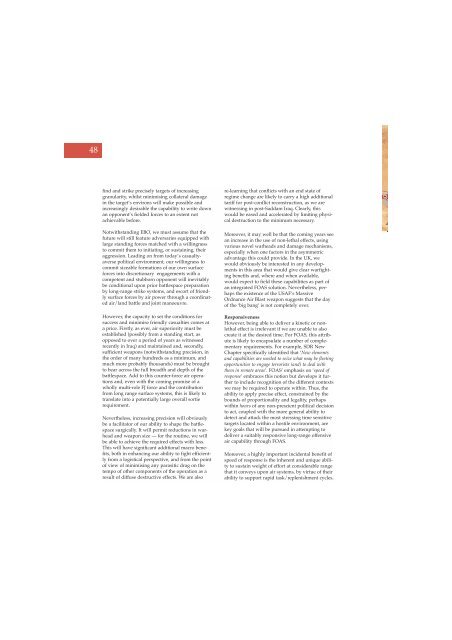Volume 6 No 4 - Royal Air Force Centre for Air Power Studies
Volume 6 No 4 - Royal Air Force Centre for Air Power Studies
Volume 6 No 4 - Royal Air Force Centre for Air Power Studies
You also want an ePaper? Increase the reach of your titles
YUMPU automatically turns print PDFs into web optimized ePapers that Google loves.
48<br />
find and strike precisely targets of increasing<br />
granularity, whilst minimising collateral damage<br />
in the target’s environs will make possible and<br />
increasingly desirable the capability to write down<br />
an opponent’s fielded <strong>for</strong>ces to an extent not<br />
achievable be<strong>for</strong>e.<br />
<strong>No</strong>twithstanding EBO, we must assume that the<br />
future will still feature adversaries equipped with<br />
large standing <strong>for</strong>ces matched with a willingness<br />
to commit them to initiating, or sustaining, their<br />
aggression. Leading on from today’s casualtyaverse<br />
political environment, our willingness to<br />
commit sizeable <strong>for</strong>mations of our own surface<br />
<strong>for</strong>ces into discretionary engagements with a<br />
competent and stubborn opponent will inevitably<br />
be conditional upon prior battlespace preparation<br />
by long-range strike systems, and escort of friendly<br />
surface <strong>for</strong>ces by air power through a coordinated<br />
air/land battle and joint manoeuvre.<br />
However, the capacity to set the conditions <strong>for</strong><br />
success and minimise friendly casualties comes at<br />
a price. Firstly, as ever, air superiority must be<br />
established (possibly from a standing start, as<br />
opposed to over a period of years as witnessed<br />
recently in Iraq) and maintained and, secondly,<br />
sufficient weapons (notwithstanding precision, in<br />
the order of many hundreds as a minimum, and<br />
much more probably thousands) must be brought<br />
to bear across the full breadth and depth of the<br />
battlespace. Add to this counter-<strong>for</strong>ce air operations<br />
and, even with the coming promise of a<br />
wholly multi-role FJ <strong>for</strong>ce and the contribution<br />
from long range surface systems, this is likely to<br />
translate into a potentially large overall sortie<br />
requirement.<br />
Nevertheless, increasing precision will obviously<br />
be a facilitator of our ability to shape the battlespace<br />
surgically. It will permit reductions in warhead<br />
and weapon size — <strong>for</strong> the routine, we will<br />
be able to achieve the required effects with less.<br />
This will have significant additional macro benefits,<br />
both in enhancing our ability to fight efficiently<br />
from a logistical perspective, and from the point<br />
of view of minimising any parasitic drag on the<br />
tempo of other components of the operation as a<br />
result of diffuse destructive effects. We are also<br />
re-learning that conflicts with an end state of<br />
regime change are likely to carry a high additional<br />
tariff <strong>for</strong> post-conflict reconstruction, as we are<br />
witnessing in post-Saddam Iraq. Clearly, this<br />
would be eased and accelerated by limiting physical<br />
destruction to the minimum necessary.<br />
Moreover, it may well be that the coming years see<br />
an increase in the use of non-lethal effects, using<br />
various novel warheads and damage mechanisms,<br />
especially when one factors in the asymmetric<br />
advantage this could provide. In the UK, we<br />
would obviously be interested in any developments<br />
in this area that would give clear warfighting<br />
benefits and, where and when available,<br />
would expect to field these capabilities as part of<br />
an integrated FOAS solution. Nevertheless, perhaps<br />
the existence of the USAF’s Massive<br />
Ordnance <strong>Air</strong> Blast weapon suggests that the day<br />
of the ‘big bang’ is not completely over.<br />
Responsiveness<br />
However, being able to deliver a kinetic or nonlethal<br />
effect is irrelevant if we are unable to also<br />
create it at the desired time. For FOAS, this attribute<br />
is likely to encapsulate a number of complementary<br />
requirements. For example, SDR New<br />
Chapter specifically identified that ‘New elements<br />
and capabilities are needed to seize what may be fleeting<br />
opportunities to engage terrorists (and) to deal with<br />
them in remote areas’. FOAS’ emphasis on ‘speed of<br />
response’ embraces this notion but develops it further<br />
to include recognition of the different contexts<br />
we may be required to operate within. Thus, the<br />
ability to apply precise effect, constrained by the<br />
bounds of proportionality and legality, perhaps<br />
within hours of any non-prescient political decision<br />
to act, coupled with the more general ability to<br />
detect and attack the most stressing time sensitive<br />
targets located within a hostile environment, are<br />
key goals that will be pursued in attempting to<br />
deliver a suitably responsive long-range offensive<br />
air capability through FOAS.<br />
Moreover, a highly important incidental benefit of<br />
speed of response is the inherent and unique ability<br />
to sustain weight of ef<strong>for</strong>t at considerable range<br />
that it conveys upon air systems, by virtue of their<br />
ability to support rapid task/replenishment cycles.
















